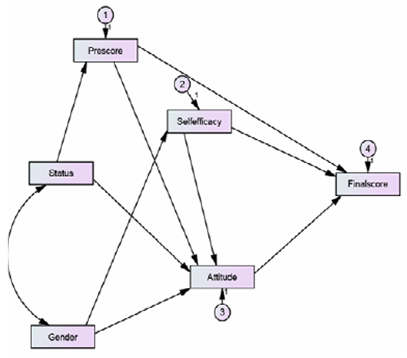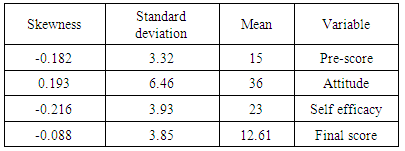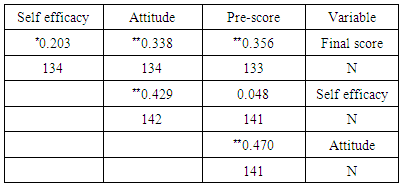-
Paper Information
- Paper Submission
-
Journal Information
- About This Journal
- Editorial Board
- Current Issue
- Archive
- Author Guidelines
- Contact Us
Applied Mathematics
p-ISSN: 2163-1409 e-ISSN: 2163-1425
2016; 6(1): 16-19
doi:10.5923/j.am.20160601.03

Relation between Math Self-Efficacy and Mathematics Achievement with Control of Math Attitude
Bahare Soleymani, Ghasem Rekabdar
Department of Mathematics, Abadan Branch, Islamic Azad University, Abadan, Iran
Correspondence to: Bahare Soleymani, Department of Mathematics, Abadan Branch, Islamic Azad University, Abadan, Iran.
| Email: |  |
Copyright © 2016 Scientific & Academic Publishing. All Rights Reserved.
This work is licensed under the Creative Commons Attribution International License (CC BY).
http://creativecommons.org/licenses/by/4.0/

The aim of this research is to investigate the relationship between students’ self-efficacy in mathematics and mathematics achievement, having attitudes towards math. Statistical population of this study is the students of Islamic Azad University, Abadan branch in the field of Chemistry engineering, who registered for basic mathematics in the spring semester, 2015. In this research, sample size is 142 people (101 male and 41 female) which were selected using cluster sampling method. The AMOS software has been used for model test. The findings of the research show that, there is not a relationship between attitude towards math and educational mathematics achievement. There is a positive relationship between self-efficacy in math and mathematics achievement.
Keywords: Mathematics performance, Attitude, Self-efficacy, Path analysis
Cite this paper: Bahare Soleymani, Ghasem Rekabdar, Relation between Math Self-Efficacy and Mathematics Achievement with Control of Math Attitude, Applied Mathematics, Vol. 6 No. 1, 2016, pp. 16-19. doi: 10.5923/j.am.20160601.03.
1. Introduction
- Life in the today modern and complicated world requires creative thoughts and dynamic ideas. Learning math effectively, can help it to form and grow well. Studying the effective parameters in learning math has been attractive to many scientists in the field of education during recent decades. Many researches have been performed and the results show that, understanding mathematics not only depends on cognitive structures, but also on motivational and emotional factors such as belief, attitudes, and anxiety. McLeod (1992) in the field of math education believes that efforts for revising math education program must discriminate for the role of interest. If the research for instruction and learning is to maximize its impact on the students and teachers, then in the researchers’ minds, emotional factors must have central role.There is an interaction between learning and attitudes. The individuals’ learning can affect attitudes and conversely, the attitudes can affect their learning. Therefore, sometimes the differences in the learned behavior are because of the people’s belief and perceptions (Dweck, and Leggett, 1988). Study in the field of attitude towards mathematics and its role in educational achievement have been started with Iken and Dragger (1961) and Iken (1979). The findings of Iken and Dragger showed that attitude towards mathematics are based on a few scopes such as enjoying math homework and the fear of facing situation in which mathematics is used. In most studies, attitude towards math has been reported as an important factor in educational achievement (e.g. Ma, 1997; Ma and Xu, 2004). Hackett and Betz (1989) have defined math self-efficacy as an assessment of people’s self-confidence in their ability for successful task performing or math specific problem. This factor can also effect on educational achievement in math, positively (Liu and Koirala, 2009; Nicolaidou and Philippou, 2003). It has been shown in some studies that both factors, attitude towards math and self-efficacy in math have positive relationship. They have also positive significant effect on educational achievement in mathematics (Nicolaidou and Philippou, 2003).
 | Figure 1. Primary path plot |
2. Method
- The main objective of the research is applied research and in terms of data collection it is descriptive correlational research. Statistical population of this research is the students of Islamic Azad University, Abadan branch, studying in the spring semester, 2015. The method of sampling is multi-stage cluster. Among Chemistry engineering and Electrical engineering students of four classes, in which all the students were taught from the same basic mathematics books, sampling was performed. The collected samples include 142 students (101 men and 41 women). The mean and standard deviation of the age is 24.21 and 6.906 years, respectively. The participants are from a wide age range. Also, among 142 participants in this research, one person did not mention its name. Minimum age of 18 years old and maximum of 50 years old was registered. To measure educational achievement in math, final grade has been considered. It is worth mentioning that basic mathematics final exam was held in common. Attitude towards mathematics contains 13 items which are measured by 4-point Likert (1: strongly disagree to 4: strongly agree). The sum of 13 items in this research shows the attitude towards mathematics. To measure math self-efficacy, Ferla, Valcke, and Cai (2009) questionnaire has been used. This questionnaire contains 8 items which are measured by 4-point Likert (1: very reliable to 4: very unreliable). Cronbach’s alpha value was calculated 0.885 and 0.68 for attitude towards mathematics and self-efficacy, respectively. Data analysis was performed in three states: first, distributing of the research variables has been descriptively investigated. Second, the correlation between research variables has been analyzed. Finally, by the use of this analysis, the research model path is investigated.
3. Findings
- Table 1 shows descriptive statistics for subscales of available quantitative variables in reported hypothesizes. Eight people were absent in the final math exam. The mean grade of the final exam is 12.61±3.85. The previous students had a mean grade of 15±3.32. The skewness index for all variables is less than 0.22. Therefore, in terms of symmetry, variables status is normal.
|
|
|
|
 | Figure 2. Estimating the parameters of the theoretical model |
4. Discussions
- The aim of this study is to identify the students’ self-efficacy beliefs in mathematics and the use of these beliefs for predicting the progress of students’ math and the relationship between attitude and educational achievement. Each model for learning and mathematics achievement can be used by the educational consultants and teachers of mathematics. The proposed model in this study was verified and it is concluded that, even though correlation between attitude and the grade was significant, and the value was even more than the value for simple correlation between self-efficacy and final grade; in the proposed model, the total effect of attitude on math performance has not been significant. The results show that there is a positive significant relationship between self-efficacy and mathematics achievement. Therefore, we can claim that high positive self-efficacy has positive impact on mathematics achievement. In contrast, low self-efficacy may have negative impact on students’ mathematics achievement. Therefore, teachers can predict educational status of the students, or to help scholars in order to increase their self-efficacy.
ACKNOWLEDGEMENTS
- This article is resulted from a research project which financed by Islamic Azad University Abadan branch.
 Abstract
Abstract Reference
Reference Full-Text PDF
Full-Text PDF Full-text HTML
Full-text HTML


